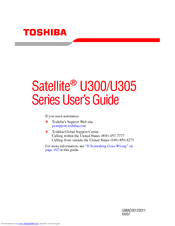Toshiba U305 S57402 - Satellite - Pentium Dual Core 1.46 GHz Manuals
Manuals and User Guides for Toshiba U305 S57402 - Satellite - Pentium Dual Core 1.46 GHz. We have 1 Toshiba U305 S57402 - Satellite - Pentium Dual Core 1.46 GHz manual available for free PDF download: User Manual
Toshiba U305 S57402 - Satellite - Pentium Dual Core 1.46 GHz User Manual (231 pages)
U300-ST3091 User's Guide
Table of Contents
Advertisement
Advertisement
